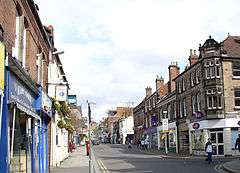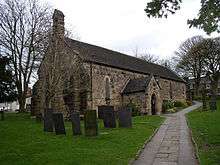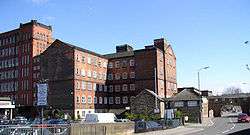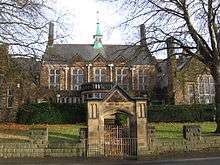Belper
Coordinates: 53°01′44″N 1°28′30″W / 53.029°N 1.475°W
| Belper | |
 King Street |
|
 Belper parish highlighted within Derbyshire |
|
| Population | 21,823 (civil parish, 2011)[1] |
|---|---|
| OS grid reference | SK351476 |
| Civil parish | Belper |
| District | Amber Valley |
| Shire county | Derbyshire |
| Region | East Midlands |
| Country | England |
| Sovereign state | United Kingdom |
| Post town | BELPER |
| Postcode district | DE56 |
| Dialling code | 01773 |
| Police | Derbyshire |
| Fire | Derbyshire |
| Ambulance | East Midlands |
| EU Parliament | East Midlands |
| UK Parliament | Mid Derbyshire |
|
|
Belper is a town and civil parish in the local government district of Amber Valley in Derbyshire, England, located about 7 miles (11 km) north of Derby on the River Derwent. As well as Belper itself, the parish also includes the village of Milford and the hamlets of Bargate, Blackbrook and Makeney. As of the 2011 Census, the parish had a population of 21,823. Originally a centre for the nail-making industry since Medieval times, Belper expanded during the early Industrial Revolution to become one of the first mill towns with the establishment of several textile mills; as such, it forms part of the Derwent Valley Mills World Heritage Site.
History
At the time of the Norman occupation, Belper was part of the land centred on Duffield held by the family of Henry de Ferrers. The Domesday Survey records a manor of "Bradley" which is thought to have stood in an area of town now known as the Coppice. At that time it was probably within the Forest of East Derbyshire which covered the whole of the county east of the Derwent. It was possibly appropriated by William de Ferrers, 4th Earl of Derby at some time after it was disafforested in 1225 and became part of Duffield Frith.[2]
The town's name is thought to be a corruption of Beaurepaire – meaning beautiful retreat – the name given to a hunting lodge, the first record of which being in a charter of 1231. This would have been the property of Edmund Crouchback, 1st Earl of Lancaster who died in 1296, the record of his estate mentioning "a capital mansion". The chapel built at that time still exists. Originally consecrated in 1250 as the Chapel of St Thomas, it was rededicated to St John during the reign of King Henry VIII. St John's Chapel is still in use today and is thought to be the oldest building still standing in Belper.



The coal deposits of Derbyshire are frequently associated with ironstone within the clay substrate. Initially obtained from surface workings, it would later have been mined in shallow bell pits. It is thought that this was important for the de Ferrers family, who were ironmasters in Normandy.[3] By the reign of Henry VIII Belper had grown to a substantial size. It is recorded that in 1609 fifty-one people died of plague.[4] However, in a Parliamentary Commissioners' report of 1650 regarding Duffield and its chapelries, Belper is described as "a hamlet appertaining to Duffield".[5]
From at least the 13th century there were forges in the Belper and Duffield areas and iron-working became a major source of income, particularly nail making. By the end of the 18th century there were around 500 workshops in the town supplying nails to the newly built textile mills. The workshops were eventually superseded by machinery during the 19th century. Some of the nail-makers' houses are still in existence and form part of local tours of the town.
The industrialist Jedediah Strutt, a partner of Richard Arkwright, built a water-powered cotton mill in Belper in the late 18th century: the second in the world at the time. With the expansion of the textile industry Belper became one of the first mill towns. In 1784 Strutt built the North Mill and, across the road, the West Mill. In 1803 the North Mill was burnt down and replaced by an new structure designed to be fireproof. Further extensions followed, culminating in the East Mill in 1913 – a present-day Belper landmark. Although no longer used to manufacture textiles the mill still derives electricity from the river, using turbine-driven generators.
Strutt had previously patented his "Derby Rib" for stockings, and the plentiful supply of cotton encouraged the trade of framework knitting which had been carried on in the town and surrounding villages since the middle of the previous century. Mechanisation arrived about 1850, but by that time the fashion for stockings for men was disappearing. However elaborately patterned stockings, for ladies especially, were coming into vogue, and the output of the Belper "cheveners" was much in demand.
The construction of the North Midland Railway in 1840 brought further prosperity. Belper was the first place in the UK to get gas lighting, at a works erected by the Strutts at Milford. Demand was such that in 1850, the Belper Gas and Coke Company was formed, with a works in the present Goods Road. Electricity followed in 1922 from the Derby and Nottingham Electrical Power Company's works at Spondon. The first telephones came in 1895 from the National Telephone Company. The end of the century also brought the motor car, CH218, owned by Mr. James Bakewell of the Elms being possibly the first.
Belper remained a textile and hosiery centre into the 20th century. Meanwhile, other companies were developing: iron founding led to Park Foundry becoming a leader in the solid-fuel central-heating market; Adshead and Ratcliffe had developed Arbolite putty for iron-framed windows; Dalton and Company, which had been producing lubricating oils, developed ways of recovering used engine oil proving useful during the Second World War. In 1938, A. B. Williamson had developed a substance for conditioning silk stockings; the introduction of nylon stockings after the Second World War seemed to make it redundant, but mechanics and fitters had discovered its usefulness in cleaning hands and it is still marketed by Deb Group as Swarfega.
Government
Before 1983 the town gave its name to the Belper constituency, which from 1945 to 1970 was the seat of George Brown, the deputy leader of the Labour Party.
Geography

Belper is 8 miles (13 km) north of Derby and is in the valley of the River Derwent. The town had a population of 20,548 living in 8,790 households according to the 2001 census.[6]
As well as Belper itself, the civil parish also includes the village of Milford and the hamlets of Bargate, Blackbrook and Makeney.
Blackbrook
The hamlet of Blackbrook is located 2 miles (3 km) west of Belper on the A517 Ashbourne road.
Economy
Belper's economy was traditionally reliant on manufacturing industry and numerous goods were made in the town. Cotton spinning and textile production were major employers virtually for much of the 19th and early 20th centuries. The large East Mill and the smaller North Mill are now all that remain of the industry and are preserved as part of the Derwent Valley Mills world heritage site. After the Second World War, J. W. Thornton, the chocolate maker, moved into the town from Sheffield, which helped to alleviate the employment problems arising from the contraction of the earlier industries. In recent years, the company completed a move to a new site a few miles away in Swanwick. Today, the main employment sectors are retail and services although some manufacturing industry remains. The main shopping area is centred on King Street. The town has two supermarkets, the Co-operative and Morrisons, and two discount shops, Poundland and B&M Bargains.
Transport
Road
The A6 is the major through-road of the town and runs parallel to the River Derwent to the west.
Rail
Belper railway station is situated on the Midland Main Line. Regular trains between Derby and Matlock on the Derwent Valley Line are almost the only services to stop there, although one main line service per weekday stops each way and the Friends of the Derwent Valley are campaigning for more.
Buses
The town is served by regular bus services to Derby and surrounding towns and villages as well as longer routes to Manchester and London. The major operator is Trent Barton who operate the bus garage on Bridge Street.
Religion
The oldest church still used for its original purpose is the Belper Unitarian Church, built in 1788. The present Methodist church was opened on 28 June 1807 and was originally built to hold 1,400 worshippers.
St Peter's Anglican Church, a prominent landmark in the town, was built in 1824 to replace the smaller 13th century St John's Chapel which is now used as a town council and heritage chamber. A second Anglican church, Christ Church, was built in 1850. A local saying calls St Peter's "the low church in the high place" and Christ Church "the high church in the low place" based on their different liturgical traditions.
The town is also home to a Baptist, a spiritualist, a Roman Catholic and a further Methodist church at Openwoodgate, as well as Belper Community Church which meets at Whitemoor Day Centre twice a month.
Culture
Sport
Belper Town F.C. play their home games at Christchurch Meadow[7] and are currently in the Northern Premier League Division One South. They are nicknamed the Nailers as a reference to the historical nail manufacturing industry in the town.
Poetry Trail
In 2009, members from two of the town's poetry groups completed a poetry trail in memory of local poet Beth Fender, who died in 2002.[8] Beth's Poetry Trail consists of 20 poems situated in a variety of locations in the town, such as outside Belper Library. Poems by Emily Dickinson, Philip Larkin and Spike Milligan are included on the trail, as well as Beth's own poetry.
Awards
In 2014, Belper was presented with the High Street of the Year award for the Market Town category, as well as winning the award overall. The judges stated "Belper is blessed with a wonderful history as a World Heritage Site but has much to offer as a thriving market town as well. The judges felt that this outstanding application demonstrates how much more can be done to transform an outwardly successful town centre into a go-to destination for locals and visitors alike." Belper won against towns and high streets such as Brighton, Colwyn Bay and many other places.[9]
Music
Belper Singers are an experienced chamber choir of some 25 voices, who sing both sacred and secular works. They give about five performances a year, including singing in various cathedrals.
Belper is also home to a weekly folk club welcoming singers, instrumentalists, poets, readers and audience members. Two traditional dance teams make their home in the town: Heage Windmillers (rapper) and Makeney Morris (Cotswold morris).
Education
Primary schools
There are eight primary schools which feed the single secondary school:
- Holbrook Primary School;
- St Elizabeth's Primary School;
- St John's Primary School;
- Herbert Strutt Primary School;
- Pottery Primary School;
- Long Row Primary School;
- Ambergate Primary School;
- Milford Primary School.
Secondary schools
Belper School and Sixth Form Centre[10] has approximately 1,400 pupils aged 11–18. It was originally named "Belper High School" when it was built in 1973, and is adjacent to Belper Leisure Centre. Famous people to have attended the school include Ross Davenport – winner of two swimming gold medals at the 2006 Commonwealth Games – and Alison Hargreaves, holder of a number of mountaineering records.

Herbert Strutt Grammar School was among the Strutt family's bequests to the town. It became a middle school in 1973 with the opening of Belper High School, and latterly a primary school, in use as such until spring 2008 when it was replaced by a new building on a different site. Notable among its pupils were the actors Alan Bates and Timothy Dalton.
For a number of years from 1979, the innovative Rowen House School provided education on democratic principles. Also, during the 1970s and 1980s, Belper was the site of an experimental three-tier education system, comprising a number of primary schools (age 5–9 years, referred to as "first" schools), feeding into two main secondary schools (age 9–13 years, referred to as "middle schools"), pupils from both then usually attended a single American-style high school (age 13–18 years). In the mid-1980s, this scheme was abandoned, and the current two-tier system adopted. At the same time, one of the two secondary schools, Parks Secondary School, was closed down and the buildings, which were in a poor state of repair, demolished. In recent years, the site of the former Parks Secondary School has been used for a new school.
International links
Belper is twinned with Pawtucket, Rhode Island after Samuel Slater – an apprentice of Jedediah Strutt – went there and founded the American cotton spinning industry.
Belper made international news in 2001 after rejecting a gift of a large fibreglass Mr. Potato Head model from Pawtucket, as some residents considered it "hideous".[11] The statue was refurbished and returned in 2015, though opinion is still divided.[12]
Famous residents
- Andrew Shaw, scorer for the Professional Darts Corporation, was born in Belper in 1968
- Andrew Jarrett, tournament referee at Wimbledon since 2006
- George Brown, Baron George-Brown Labour politician, Foreign Secretary 1965–67, represented Belper from 1945 until 1970, but never actually lived here; he kept a flat in Swadlincote at the opposite end of the constituency.
- Maxwell Caulfield, stage, film and television actor
- Timothy Dalton, actor, the fourth James Bond, was brought up here[13]
- Ross Davenport, Commonwealth games double gold medalist swimmer
- Monica Edwards, children's writer, was born here in 1912[14]
- Penelope Mortimer, novelist and wife of John Mortimer, author of The Pumpkin Eater, was the daughter of the vicar of St Peter's church
- John Lawton, novelist, author of Black Out and Blue Rondo, was born here
- Suzy Kendall, first wife of Dudley Moore, actress in British and Italian films
- Will Hay, comedian and actor, lived in Belper while performing locally in the 1920s
- Tracy Shaw, actress, played Maxine Peacock (1995–2003) in Coronation Street
- Alan Bates and Graham Haberfield, actors, both attended Strutt's School
- Alison Hargreaves, mountaineer, grew up in Belper and attended Belper High School
- Samuel Slater, "father of the American Industrial Revolution", grew up on Chevin Road[15] and apprenticed at Milford[16]
- Bombardier Charles Stone who was awarded the VC was born, and is buried, here[17]
- Jedediah Strutt, inventor, opened his first mill in Belper (1777)[18]
- Frank Swettenham, colonial ruler of Malaya, author, was born here[19] in 1850
- Audley Bowdler Williamson, inventor of Swarfega and founder of Deb Ltd, once based in Belper, now in Denby
- Admiral Sir Trevor Alan Soar, a former Commander in Chief Fleet of the Royal Navy, was born in Belper.
- Ron Webster, professional footballer, born here in 1943. A full back, Webster played 455 league games for Derby County between 1960 and 1978.
- Nigel Vardy, mountaineer who has grown up in Belper and attended Long Row Primary School, Herbert Strutt Middle School and Belper High School
References
- ↑ "Neighbourhood Statistics". Office for National Statistics. Retrieved 8 October 2014.
- ↑ Turbutt, G., (1999) A History of Derbyshire. Volume 2: Medieval Derbyshire, Cardiff: Merton Priory Press
- ↑ projects/eastmidsfw/pdfs/26deras.pdf Dave Barrett, Derbyshire County Council, East Midlands Archaeological Research Framework: Resource Assessment of Medieval Derbyshire
- ↑ 'Parishes: Doveridge – Duffield', Magna Britannia: volume 5: Derbyshire (1817), pp. 129–142. URL: http://www.british-history.ac.uk/report.aspx?compid=50727. Date Retrieved 27 August 2008.
- ↑ Bland, J., (1921) Old Duffield Village, Church, and Castle, With some Personal Reminiscences, Derby:Harpur and Son
- ↑ "2001 Census: Key Statistics: Parish Headcounts: Area: Belper CP (Parish)". Neighbourhood Statistics. Office for National Statistics. Retrieved 16 August 2009.
- ↑ "Belper Town Football Club". Retrieved 10 September 2012.
- ↑ "Poetry trail celebrates ex-nurse's passion for words and love of life". Derby Telegraph. Retrieved 31 December 2012.
- ↑ "Great British High Street Awards 2014 Category Winners". The Great British High Street. Retrieved 21 November 2014.
- ↑ "Belper School and Sixth Form Centre". Retrieved 10 September 2012.
- ↑ Walker, Bob (3 October 2014). "Mr Potato Head". BBC Today programme. Retrieved 23 September 2015.
- ↑ "Mr Potato Head statue to return to Belper". BBC News. 26 May 2015. Retrieved 23 September 2015.
- ↑ Timothy Dalton biography Retrieved June 2007
- ↑ Monica Edwards – the Authorised Biography by Brian Parks
- ↑ Everett et al. (Slater Study Group) (2006) "Samuel Slater – Hero or Traitor?" Milford, Derbyshire: Maypole Promotions
- ↑ Samuel Slater at Biography.com Retrieved June 2007
- ↑ Derbyshire at VictoriaCross.org Retrieved June 2007
- ↑ "Jedediah Strutt Biography". Spartacus.schoolnet.co.uk.
- ↑ Frank Swettenham at biography.com Retrieved June 2007
- Naylor, P. (Ed) (2000) An Illustrated History of Belper and its Environs Belper: M.G.Morris
External links
| Wikimedia Commons has media related to Belper. |
| Wikivoyage has a travel guide for Belper. |
- Belper Town Council
- BBC: Historical account of the Belper nailers
- Belper Historical Research Website
- Belper Local Business Directory